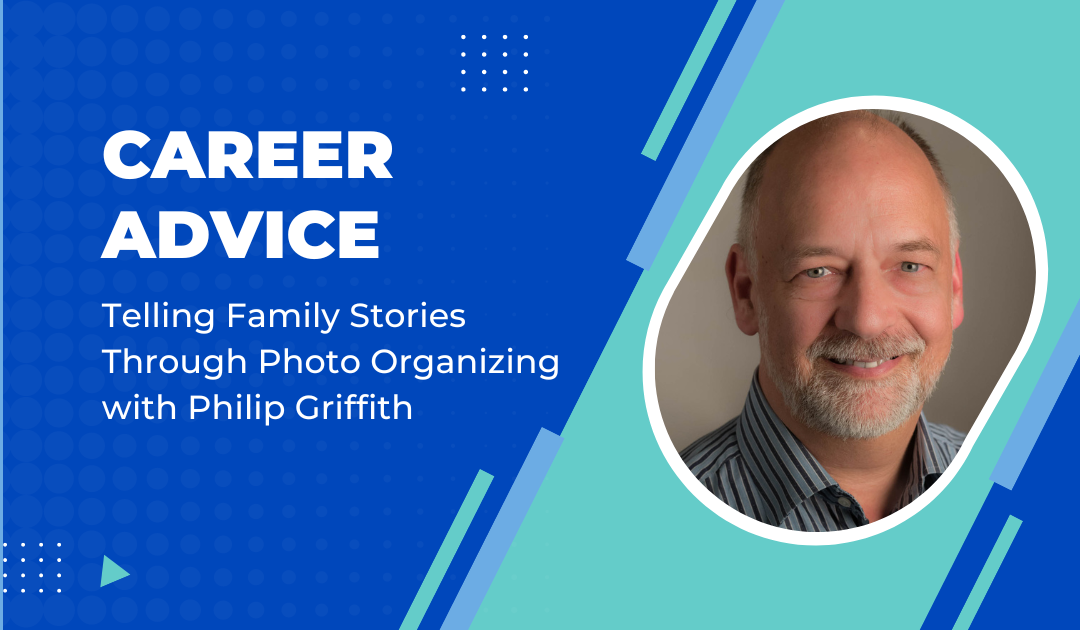 Philip Griffith talks about how he turned his passion for the arts and his love of telling family stories into a career as a photo manager.
Philip Griffith talks about how he turned his passion for the arts and his love of telling family stories into a career as a photo manager.
As a professional ballet and modern dancer, Philip Griffith loved making classical tales like Swan Lake, Sleeping Beauty, and The Nutcracker come to life on stage. At the age of 28, with his dancing career coming to an end, Philip developed new administrative skills while continuing to be involved in the arts through his own nonprofit and with International Arts Festivals.
When Philip and his wife adopted their first son from Guatemala, they had a new story to tell. It was at this point that they were introduced to “life books” which use pictures, documents, and memorabilia to tell a child’s story from birth, through adoption, and life as part of the family.
While creating life books for his own sons and other adoptive families, Philip soon faced the challenge of merging decades of both printed and digital photos into one organized collection. Realizing there was a need for this service, Philip jumped in with both feet in 2011 and opened PSG Photo Solutions and became one of the earliest members of The Photo Managers.
During this Career Advice from the Pros session, Philip sat down with The Photo Managers Founder Cathi Nelson to talk about his story and what he would like new or aspiring photo managers to know about the field.
How would you describe your business to someone meeting you for the first time?
I tell people that I help busy families use their photos to tell their stories so that they will last for generations.
Our compay, PSG photo solutions, is based on our initials, Philip and Susan Griffith. We also use that to represent Photos, Stories, and Generations. That acronym has helped me be able to communicate what I do. My background is telling stories and I got into this by telling a story, so I like to help my clients tell their stories and find the stories embedded in their collections that they may not know about.
What type of work is the heart of your business?
I am fortunate in that my wife, Susan, works with me. She has a background in graphic design and layout, so she designs all the books, posters, and anything that we’re going to print. She’s got that eye for detail and making sure that all the margins are even and the sizing is perfect.
I really love the slideshows and I also enjoy organizing and scanning. It’s very methodical, and it gives me a chance to actually look at the collection and recognize patterns that I can talk to the client about.
What’s an example of some of the projects that you are working on now?
One example of a project we are working on is a scrapbook that the client is having us scan. They plan to turn it into a photo book and we are scanning the pages and getting them ready. We are also finishing up a scanning project and getting ready to start making a photo book for a client who found five moving boxes of photos in her basement. It took about 13 months of doing a half-day session per month to get everything scanned because some photos were in albums and others had to be taken out of frames.
Do you offer digital photo organizing or do you focus mainly on scanning and analog photo collections?
Most of my clients start off with the analog. At times, they then move to digital. But I’ve only had a couple where it was just the digital-only. I don’t enjoy working on digital collections as much because the work is straining for your eyes. I’ve come to the point where three hours is about my limit. I prefer to bring projects into my studio where I can work for a couple of hours, take a break, go outside, play with the dog, and then come back and do maybe a couple more hours.
How did you find clients when you were first starting out as a photo organizer?
My first client was for scanning and they found me on the web. At first, most of my clients were what I call “one and done” in that they only wanted one thing from me. One client who contacted me early on phoned me while she was standing at Walgreens. She was frustrated because every time she tried to do a scan there at Walgreens, she got funny patterns on the photo because it had a mottled finish. So she looked up photo scanning on her phone, I came up, and she realized I was actually only a block and a half away.
How do you use networking with other organizations to grow your business?
Because photo organizing was, and still is, such a new business, I discovered that networking and word-of-mouth were going to be the best way for me to get clients.
I realized that professional organizers are already working in people’s homes, but many don’t like to work with photos. So the National Association of Professional Organizers (NAPO) was a really good referral partner because we both had clients that needed each other’s services. My best clients were referrals from professional organizers because these clients understood that, if they didn’t have the time, they could pay someone to help them or do it for them quickly and very economically.
Professional organizers, just like photo organizers and other service industries, however, serve a wide variety of clientele. I found that I needed to connect with professional organizers that were specifically working with the same type of clients that I really wanted. Now that I live in Ohio, where are not as many professional organizers, I’ve also started looking at financial planners and other professionals.
Who is your ideal client?
It took me a long time to figure this out, but my ideal client is a family who still has kids at home. Typically, the oldest children are in high school and they may have still younger kids. At this point, that still means that they have both analog and digital photos and, as parents, they are investing in their children.
One way to recognize if people are investing in their children is if they are sending them to private school, or if their children are heavily involved in arts or sports. When I say arts or sports, I mean they’re taking private art lessons, music lessons, or they’re on the club sports team, not just the school or the civic sports team. This is where I draw on my background. As an adoptive father, I wanted to pour into my children by them seeing their photos and their stories, and the connections that they make with our family and with others. That’s the connection I’m making with my ideal clients, I show them that this is another way of investing in your children.
What do you love most about being a photo manager?
I love the creativity involved, and I love that there’s always something new. Once I stopped dancing professionally, it was really hard, but I realized that I still needed to find work that consisted of short-term projects and allowed me to collaborate with other people. So, for me, this business is perfect in that I’m working with a client, I’m working with my wife, and we’re all working on a project that’s going to happen in the next three to six months. At the end of the project, we produce a finished product, a performance, if you will. It could be a slideshow, a book, or even just the scanned collection.
What is one thing you don’t like about being a photo manager?
The thing that I didn’t like for the longest time was the business aspect. It’s taken me a long time to realize I know more about business than I thought I did. I would beat myself up because I don’t have an MBA or all the degrees in business. When I lived in Boston, all around me were people with graduate degrees from Harvard, MIT, Boston College, or Boston University, and I got really insecure. I think that the insecurity, feeling like I don’t know enough, has been one of the hardest things about this business. But one of the things I know about myself is that I love to learn. And if I don’t know something, I know how to go out and find it and learn it myself.
Watch the full interview below to learn more from Shelley as she answers questions from the audience about pricing, community connections, and more.
Key Takeaways:
#1: Photo organizing is a form of storytelling! Neglected photo collections can contain forgotten memories that bring family history to life when they are properly curated.
#2: Creating an accessible, enjoyable photo collection is one way that parents invest in their children.
#3: Networking with other professional organizations is a great way to find your ideal clients and develop lasting relationships.


Recent Comments